(Based on my article published at: https://www.rappler.com/views/imho/207073-baybayin-modernization-philippine-handwriting-system)
On April 23, 2018, the National Writing System Act (House Bill 1022), a bill filed by Rep. Leopoldo Bataoil (2nd District, Pangasinan), supported by the Department of Education (DepEd), the National Commission for Culture and Arts (NCCA), and Baybayin Buhayin Movement, was approved by House Committee on Basic Education and Culture. The bill aims to use Baybayin script as the country’s national writing system.
Despite this wonderful news, we have a question to ponder: are we ready for the enormous changes Baybayin may bring in our culture and daily living? Will Baybayin be suitable for the modernized lifestyle of the Filipinos? (READ: [OPINION] Can you read Baybayin?)
There are some rules to follow when we are writing the Baybayin. The letters ‘e’ and ‘i’ are written in the same format. The same goes with ‘o’ and ‘u’ where they are written in the similar way. There is no distinction between these letters especially when we are writing the vowels with the consonants. In order to distinguish the ‘e/i’ and ‘o/u’, a kudlit (usually a dot or a comma or a small line) is placed at the top of the Baybayin for the letter ‘e/i', while it is drawn at the bottom for ‘o/u’. Before the Spanish era, the last letter was not written, but it was changed by an Augustinian Priest, Francisco Lopez, when he decided to put ‘+’ or ‘x’ at the bottom of the Baybayin scripts. This means that the vowel of the Baybayin is not read. Thus, the last letter can be written and read also.
The Philippines is said to be the melting pot of the cultures in South East Asia, with more prominent cultural influences from Europe and America. One of these influences is language. We acquired new letters such as ‘c’, ‘f’, ‘ñ’, ‘j’, ‘q’, ‘v’, ‘x’, and ‘z’, which are not originally included in the Baybayin. There are some adjustments that we are doing to fill up these inadequacies. For example, in writing the word Philippines or Filipino in Baybayin, instead of using the letter/s ‘f’ or ‘ph’, we alter the letter with ‘p’ which has almost similar sound. This is also applicable with the letters ‘v’, ‘x’, and ‘z’ which sound-like ‘b’ and ‘s’. There are letters like ‘ñ’, and ‘j’, that when we add vowel ‘a’ are read as ‘nya’, and ‘dya’. These letters are also written in two syllables or Baybayin scripts. The letter ‘c’ is a little bit special since there are words where we can pronounce it as ‘k’ e.g. calling card; and sometimes in ‘s’ like in center, and cellphone. The last letter ‘q’, when added with letter ‘a’, is sounds-like ‘ka’, but when added by dipthongs ‘ua’, it is read as ‘kwa’. Thus, it will be written to two Baybayin as well.
As the new generations of Filipino come, the languages that we have also evolve and develop. Through simply hearing these languages, we can guess the generation on which they are born. Aside from local language evolution, new discoveries, or inventions around the world have their own nomenclature and adapted or assimilated by the Filipinos in our daily life usage. Examples of these are refrigerator, computer, jeep, and so on. We are writing them in Filipino according on how we pronounce them.
There are some rules to follow when we are writing the Baybayin. The letters ‘e’ and ‘i’ are written in the same format. The same goes with ‘o’ and ‘u’ where they are written in the similar way. There is no distinction between these letters especially when we are writing the vowels with the consonants. In order to distinguish the ‘e/i’ and ‘o/u’, a kudlit (usually a dot or a comma or a small line) is placed at the top of the Baybayin for the letter ‘e/i', while it is drawn at the bottom for ‘o/u’. Before the Spanish era, the last letter was not written, but it was changed by an Augustinian Priest, Francisco Lopez, when he decided to put ‘+’ or ‘x’ at the bottom of the Baybayin scripts. This means that the vowel of the Baybayin is not read. Thus, the last letter can be written and read also.
The Philippines is said to be the melting pot of the cultures in South East Asia, with more prominent cultural influences from Europe and America. One of these influences is language. We acquired new letters such as ‘c’, ‘f’, ‘ñ’, ‘j’, ‘q’, ‘v’, ‘x’, and ‘z’, which are not originally included in the Baybayin. There are some adjustments that we are doing to fill up these inadequacies. For example, in writing the word Philippines or Filipino in Baybayin, instead of using the letter/s ‘f’ or ‘ph’, we alter the letter with ‘p’ which has almost similar sound. This is also applicable with the letters ‘v’, ‘x’, and ‘z’ which sound-like ‘b’ and ‘s’. There are letters like ‘ñ’, and ‘j’, that when we add vowel ‘a’ are read as ‘nya’, and ‘dya’. These letters are also written in two syllables or Baybayin scripts. The letter ‘c’ is a little bit special since there are words where we can pronounce it as ‘k’ e.g. calling card; and sometimes in ‘s’ like in center, and cellphone. The last letter ‘q’, when added with letter ‘a’, is sounds-like ‘ka’, but when added by dipthongs ‘ua’, it is read as ‘kwa’. Thus, it will be written to two Baybayin as well.
As the new generations of Filipino come, the languages that we have also evolve and develop. Through simply hearing these languages, we can guess the generation on which they are born. Aside from local language evolution, new discoveries, or inventions around the world have their own nomenclature and adapted or assimilated by the Filipinos in our daily life usage. Examples of these are refrigerator, computer, jeep, and so on. We are writing them in Filipino according on how we pronounce them.
Personally, I support the use of the Baybayin as our national handwriting system, but due to its character insufficiencies, I believe that modernizing or revising the rules of Baybayin before passing it as a law will make it more efficient and adaptable to the world mainstream. Furthermore, as far as I know, there are no additional suggested rules for writing Baybayin after the addition of ‘+’ or ‘x’ during the Spanish era.
Taking note of the aesthetic and the norms of Baybayin, I propose the following amendments to the rules as a guide to modernize the old handwriting system.
1. All of the Baybayin scripts will be written as it is. However, there are some exemptions that will be discussed on the latter rules.
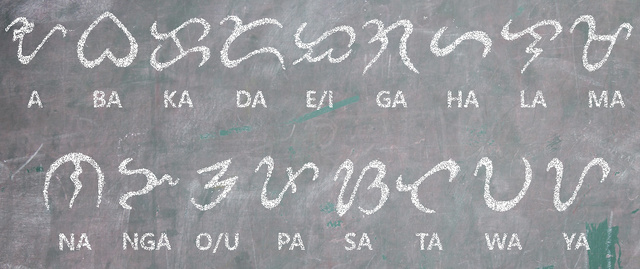
2. When writing the Baybayin vowels, there are no distinction between the ‘e’ and ‘i', and ‘o’ and ‘u’. Thus, to differentiate them to each other, the sign (-) is being recommended to be placed above and below the Baybayin scripts ‘i' and ‘u’, respectively.

3. The Baybayin scripts are all written on its based form: consonant plus the vowel ‘a’. There are symbols written above and below the Baybayin script to replace ‘a’ with the other vowels or to remove it. First, the ( . ) and ( - ) are being placed above the Baybayin script to produce a consonant with ‘e/i’ e.g. ‘be’/‘bi’, and below for consonant with ‘o/u’, e.g. ‘bo’/‘bu’. Moreover, the ‘+’ or ‘x’ sign is being placed below the Baybayin which omits the vowel ‘a’ so that only the consonant remains.
Since there is no distinction between ‘be/bi’ and ‘bo/bu’, the sign ( . ) and ( - ) are suggested to be placed on the top of Baybayin script for ‘be’ and ‘bi’, and to be written below for ‘bo’ and ‘bu’, respectively.
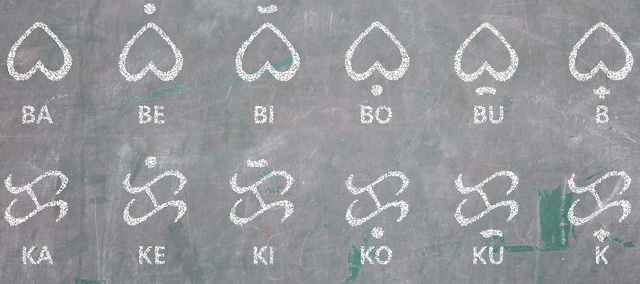
4. The letters ‘f’ or ‘ph’, ‘v’, and ‘z’ which were adopted from other countries have no equivalent Baybayin script. These are being written based on how we pronounced them. In order to use these letters, the symbol ( - ) are being suggested to be written on the side of the Baybayin script. When we pronounce ‘th’, we are blowing out air outside our mouth like when we are pronouncing ‘ph’ or ‘f’. Thus, the same rule is being recommended in writing words/sounds that have ‘th’.
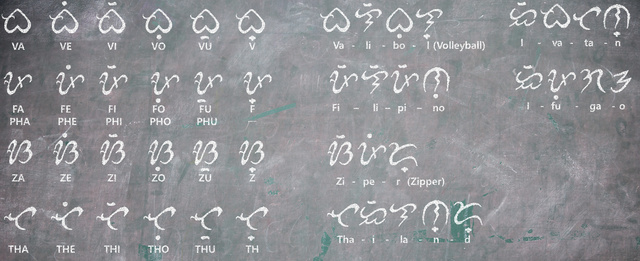
5. The letter ‘ñ’ can be read as ‘ny’ or ‘nya’ when added by the vowel ‘a’. This letter ‘ñ’ or the ‘ny’ with other vowels is very common in the Filipino vocabulary. Examples of these are kanya, pinya, ninyo, Niña, Niño etc. In Baybayin, this single letter is written in two Baybayin scripts. Because of this, it is being proposed to put (~) at the top of the Baybayin script to produce one syllable only. (See the picture below rule #6.)
6. Other than consonant letter ‘n’, there are other letters like ‘b’, ‘d’, ‘p’, ’r’, ‘s’, ‘t’, etc. that are being put together with letter ‘y’ and a vowel to form a part of a word in Filipino. Examples are pasya, nasyonalismo, oryentasyon, palya, tuwalya, batya, kompyuter, etc. Based on the rule #5, the symbol (~) will be placed above the Baybayin script. The rule #3 will always be observed also in case it is being written with the vowels ‘e, i, o, u’.
Moreover, because the word ‘sya’ is homophonous with ‘sha’ while the word ‘tya’ is homophonous with ‘tsa’ and ‘cha’ , therefore the Baybayin script of ‘sya’ for the words with ‘sh’, e.g. Shiela, Shaw Boulevard, fishbol, goldfish, etc. and ‘tya’ for the words with ‘cha’ and ‘tsa’ e.g. tsaa, chico, tsuper, sandwich etc. are being recommended to be used.
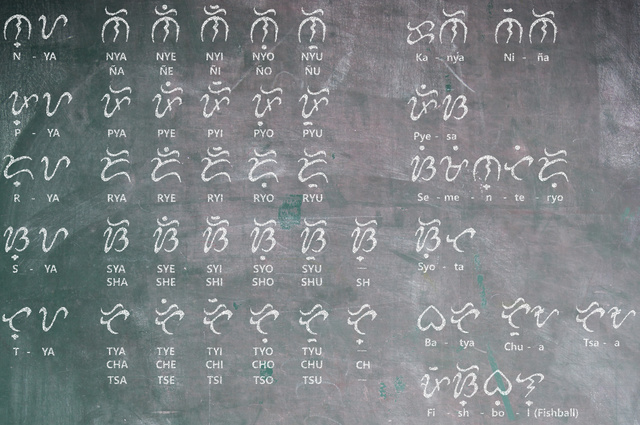
7. The letter ‘j’ or ‘dyey’ in Filipino should be written according also to rule #5.

8. The da and ra are both being represented with a single Baybayin script. Because of this, the symbol ( / ) is being suggested to be put below the Baybayin script ‘da’, forming an ‘x’, to create the Baybayin ‘ra’.

9. The letters ‘C’, ‘Q’, and ‘X’ will be written based on how we pronounce or on how we adopt the words in Filipino.
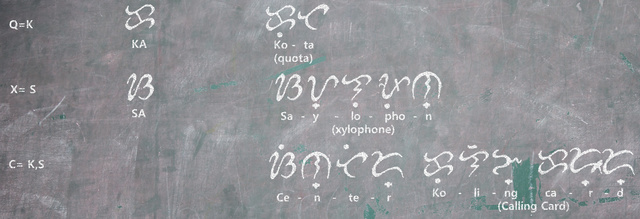
10. There are times when letter ‘Q’ is being translated as ‘kw’ in Filipino. There are also some consonants that are being written with ‘w’. Examples are kwadro, kwarto, kwatro, itatwa, pwede, lenggwahe, karwahe etc. Thus, the letter ‘Q’ and all the consonants that will be written in Filipino as consonant plus ‘w’ will be represented by drawing a second vertical line on the first vertical line of the Baybayin script.

Using an enhanced version of Baybayin (see the baybayin script below) will really help our beloved country to gain much further cultural identity. Despite the fact that this will be a very sensitive issue since amending it will transcend some field of studies like History, Linguistics, Anthropology, Sociology etc., having additional rules, before it is being implemented in the Philippines, is the only way that the Baybayin script will be of use easily in the Filipinos’ daily life. Imagine other Asian countries like Thailand, Cambodia, Laos, Chinese, Korea, Japan, etc., that have preserved their handwriting system up to this day. Their own handwriting system does not impede their growth as a country. Instead, it becomes one of the reasons why they have a very rich culture.
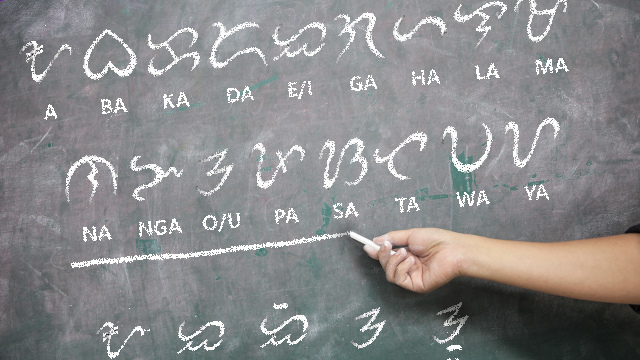
The proposed new rules aim to preserve and enrich our culture, and introduce to the whole world that the Philippines are not just a melting pot of cultures but it has its own existing culture before it adapted to the modern world. For me, modernizing the Baybayin script will not signify the end for our handwriting system. Instead, it could mean a stepping stone for progress.
Mabuhay ang Pilipinas! – Rappler.com
The author is a PhD candidate under the program of Biotechnology in the Jeju National University, Jeju City South Korea. This opinion is written to create more public awareness about the Baybayin bill. This is to call the attention of the common people, advocates, and experts; whether Baybayin should be preserved as it is, or improved so we can write it with less difficulty. The author hopes that this will be a guide or start of a more intellectual discussion, (not hate and dispute from the Filipinos) to save the almost forgotten treasure of the older generation of our country. All of the proposed additional rules have been created without the knowledge of other existing proposal, if there will be, for the amendment of Baybayin. Moreover, all of the Baybayin scripts, which are used on this article, were edited from the scripts taken here.
The author would like to thank the following persons for giving their insights and advises about his opinion on the modernization of Baybayin script: Prof. Inero Ancho, Prof. Ron Laranjo, Ms. Ayesha Sayseng, Mr. Joseph Basconcillo and Mr. Aris Rosaga.
x